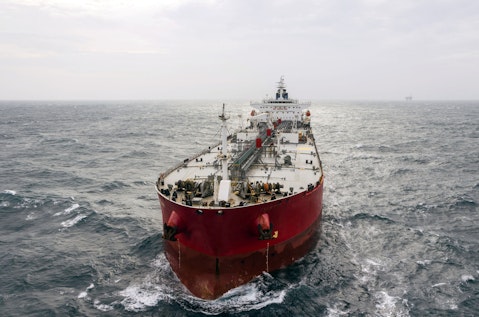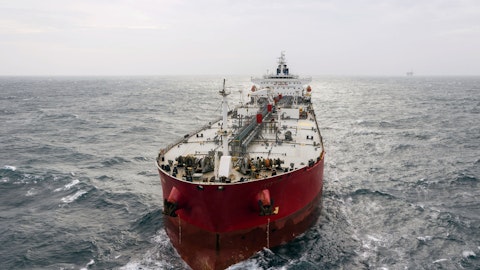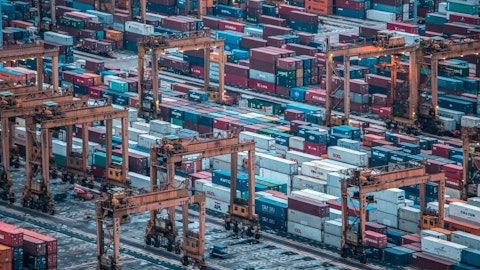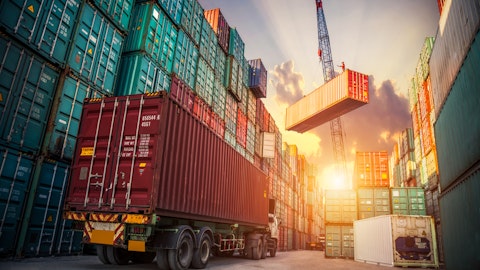Frontline Ltd. (NYSE:FRO) Q4 2022 Earnings Call Transcript February 28, 2023
Operator: Good day, and thank you for standing by. Welcome to the Fourth Quarter 2022 Frontline PLC Earnings Conference Call. Please be advised that today’s conference is being recorded. I would now like to hand the conference over to your first speaker today, Mr. Lars Barstad. Please go ahead.
Lars Barstad: Thank you. Dear all, thank you for tuning into Frontline’s fourth quarter earnings call. I know it’s been a busy day for at least, those of you who are analysts. It’s quite a few companies reporting today. I have feeling some of the questions in the upcoming Q&A will be focused on the termination of the combination agreement with Euronav, but let’s for now, focus on Frontline and the small key markets we’ve had in the fourth quarter. Although the implications of Russia’s invasion of Ukraine caused most of the headlines, we believe, from a tanker market perspective, China was the catalyst to Frontline posting the best quarterly result in over 14 years. We finally fired on all cylinders throughout the quarter and our lean and mean business model .
Let’s quickly look at our TCE numbers on Slide 3 in the deck. In the third quarter Frontline achieved $63,200 per day on our VLCC fleet, $57,900 per day on our Suezmax fleet and $58,800 per day from our LR2/Aframax fleet. And finally, the inverted earnings relationship between our segments, we’re at least temporarily reversed. So far in the first quarter of 2022, we have booked 87% of our VLCC days at $58,300 per day, 77% of our Suezmax days at the cool $72,400 per day and 68% of our LR2/Aframax days at a solid $63,900 per day. Again, all these numbers in the table are on the load to discharge basis and they will be affected by the amount of ballast days we end up having at the end of Q1. Before I give the word to Inger, let’s just quickly jump to slide four in the deck.
I’ll repeat a few key points from the Frontline fleet composition. Frontline continues to hold one of the most efficient fleets in the industry and our diversification has proven profitable for all our shareholders during 2022. Scrubber spreads continue to incentivize investments hovering north of $200 per metric ton, and we are installing scrubbers on two additional wheels only two of these left without a scrubber. The average age of our fleet is a comfortable five years Frontline is well positioned in CRI terms and also for the upcoming EU ETS considerations. I will now let Inger take you through the financial highlights.
Inger Klemp: Thank you, Lars. And good morning and good afternoon, ladies and gentlemen. Then, let’s turn to Slide 5. In the fourth quarter, we achieved total operating revenues of $353 million and we had an adjusted EBITDA of $287 million. We came in at the net income of $240 million, which is the highest quarterly net income we have had since 2008, then we had an adjusted net income of $215.5 million, the adjusted net income in the fourth quarter increased by $133 million compared with the previous quarter and that was mainly driven by an increase in our time charter equivalent earnings due to the higher TCE rates that Lars went through earlier in the presentation. This was partially offset by a general increase in expenses.
We declared a cash dividend for the third quarter of $0.30 and for the fourth quarter of $0.77, and the fourth quarter dividend gives a direct return of 17% on the share. As of December 31, 2022, we have revised the estimated useful life for our vessels from 25 years to 20 years, which is expected to increase depreciation expense by approximately $59 million 2023. Then, let’s take a look at Slide 6, the balance sheet. Total balance sheet numbers have increased with $227 million in this quarter, and the main drivers are delivery of Front Gaula, revaluation gain on the Euronav shares, increase in working capital and also the net income that we earned in the fourth quarter. As of December 31, 2022, Frontline had $556 million in cash and cash equivalents, including undrawn amounts under our senior unsecured loan facility, marketable securities and minimum cash requirements.
Then, let’s move to Slide 7. And let’s take a look at cash flow potential. We estimate average cash cost breakeven rates for 2023 of approximately $27,000 for VLCC, $21,500 for Suezmaxes, and $17,600 per day for LR2 tankers, with a fleet average estimate of about $22,300 per day. This average estimate includes start-up of two vessels and one LR2 tanker in 2023 all in the first quarter. With respect to operating expenses, we recorded $8,800 per day for VLCC, $17,600 for Suezmax and $8,700 for LR2 tankers and we dry-docked two vessels in the fourth quarter that was one VLCC and one LR2 tanker. Looking at the right-hand side, on the side, we showed free cash growth in millions and per share after debt service basis currently and a day. If we look at assumed CTC rates of $75,000 per day with five-year historic spread to be received for Suezmax and LR2 tankers, the annual fee cash potential will be more than $1.4 billion or $6.46 per share.
And with that, I think I’ll leave the word to you again, Lars.
Lars Barstad: Thank you, Inger. We are in kind of a market where the potential is substantial. If you move to Slide 8 and its recap what happened in Q4 in the tanker markets have the title here sneak peek of what’s to come. I think it’s probably not a secret that we are tremendously bullish for the next couple of years. And during the quarter, all segments from fund operates performed. it was finally the turn for the VLCCs to shine. The average weighted market earnings for tankers are actually flirting with 2004 highs. So you see in this — in the chart below on the left hand side with the yellow column. And I think kind of in general, the market hasn’t recognized how substantial Q4 ended up being and why — this is the average weighted earnings for all tankers and obviously what’s happening on MRs, on LR1s, LR2s, FRS and VLCCs together, has made this possible.
We are in the market conditions where it’s not only the VLCC outperforming is basically all segments performing. Chinese imports are back above pre-COVID levels hovering around 10 million barrels per day and the VLCC shipments to China are actually at all time high. And I would like to say the big ships are back. During Q4, we saw the G7 crude oil price cap come into effect on December 6, we have seen already a lot of crude oil and fuel oil being redirected to — around Europe to Asia and Middle East predominantly. So the effect of the 5 December cap was somewhat muted. We also need to keep in the back of our head that during to a mild winter in the northern hemisphere, oil prices were also hovering below or around $80 per day, making Russian crude comfortably price below the price cap.
Let’s move to Slide 9 and look at what we believe is the three major themes as we embark on again upcycle. First is oil demand. As long as we have oil prices in the area where we are now hovering $80 to $90 per barrel, we believe oil demand will continue to be fairly strong. If you look at the chart at the bottom left, this is from EIA is kind of confused — it’s not a confusing shot, it goes in one direction, but it shows a lot of volatility going forward. But by the end of 2024, EIA expects global oil consumption to be more than 4 million barrels per day higher than where we are now. Asia, in particular, China, is expected to be the key driver as China is returning from COVID lockdowns. The second big part of this equation is obviously fleet supply.
Total tanker fleet growth is set to turn negative during 2024. This has not been seen since 2002 and if you look at the middle chart below, you’ll see the columns for the various years of growth. And as we kind of go through 2023, we expect to have about 3% growth in the total fleet of tankers globally that will be reduced to 1% in 2024 and it will actually turn negative during the year. And in 2025, the overall fleet is expected to reduce by 1%. A change in trade dynamics may actually accelerate this. Right now, 12% of the tanker fleet is above 20 years. We’ve had very limited scrapping and ships are in fact trading kind of beyond their expected lifespan. So obviously, any regulatory changes or any initiatives in this respect could accelerate the fleet reduction.
World Seaborne Trade, this is the bottom right-hand graph is expected to grow by 6% to 7% annually over the next two years. This is a function of the key demand centers being in Asia and key production growth coming out of US and Latin America, predominantly. The overall order book stands at 5% or actually slightly below and now we’re looking at delivery windows in 2026. Let’s move to Slide 10 and look at a bit further on the order books. During last year, we have the lowest contracting activity in decades. If you look at the graph on the top left-hand side, you will not find one column since 1996 and this is the history I actually have available that is lower than the sum of around 7 million deadweight tonnes that was contracted in 2022. And as we go into 2023, the activity continues to be limited.
If you look at our VLCC fleet isolated, there are now during 2023 will have a 112 VLCCs passing 20 years. That will be 13.2% of the entire fleet. The order book stands at 28 units and that represents 3.3% of the existing fleet. If we look at the Suezmaxes, this is even more pronounced. By the end of 2023, 85 vessels will be above 20 years. That’s — it represents 14.5% of the fleet. The order book is at a modest 10 vessels and that represents 1.7% of the fleet. The LR2 market, it’s a bit more balanced, there’s a few more ships on order but they have the same age profile. So about 400 LR2s in the world, 25 will turn 20 during 2023, that represents about 6% of the fleet. The order book is currently at 51, that represent 12.8% of the fleet. A point that I made before on the LR2 is that effective kind of age of an LR2 start to or the effectiveness of trading an LR2 starts to be reduced after it 15 years due to quite a few charters limiting their chartering activity for vessels that go beyond the 15-year threshold.
If we then move to Slide 11 and we’re going to look at some of the key exporting regions and what the states — what kind of the market is. I mentioned earlier that the three major themes are with the oil demand fleet supply and distances. But in order for demand to be kind of sufficient supply we need production as well. World crude oil exports are now back to pre-COVID levels finally. We’re hovering about 42 million barrels per day of ocean-going volumes. That’s just north of 40% of global oil production. West Africa continues to struggle but saw a modest improvement in the fourth quarter. Latin America is becoming an increasingly important export region in particular Brazil and recently Guyana are the keys for growth. Russian exports are surprisingly resilient and exports are back to pre-invasion levels.
I think some of the statistics there may be colored by kind of increased exports ahead of the 5 December price cap, but still Russia still seems to find a home for its Crude. U.S. exports continue to be firm and we’re particularly surprised after the SPR release stopped during November in or more or less stopped during November last year. US continues to be the region where we will see production increases and over the next couple of years you as the loan will actually represents close to 80% of new foil coming online globally. Then if we move to Slide 12 and go through the summary. So Frontline reported the highest quarterly net income since 2008, a cool $240 million. Our cash dividend, which is obviously the combination of Q3 and Q4 is the $1.07.
We took delivery of the three remaining VLCC new buildings from Hyundai and sold one VLCC and one Suezmaxes both 2009 builds. As far as we see it, China took center stage in the fourth quarter and imports in China — to China are back to pre-COVID levels. Oil demand continued to recover. There is a limited fleet supply and an increasing ton-mile demand are the key drivers for the years to come. We continue to believe that Frontline’s efficient and transparent business model will generate shareholder returns. And with that, I would like to open up for questions.
See also 10 Largest Economies in Europe and 25 Biggest Connecticut Companies and Stocks .
Q&A Session
Follow Frontline Ltd (NYSE:FRO)
Follow Frontline Ltd (NYSE:FRO)
Operator: Now we’re going to take our first question and it comes from the line of Omar Nokta from Jefferies. Your line is open. Please ask your question.
Omar Nokta: Thank you. Thanks, Lars. Thanks, Inger, for the update. Clearly, a lot of positive themes developing here, you touched here on the last slide Lars about the new building for our brand now being officially complete with the delivery of these final 3 VLCCs, you did sell a couple of older tankers the Suez and the APRA, what are you thinking about Frontline’s fleet here strategically as we move forward Asset large scale M&A. How do you think about the fleet from here, the first time in many years. I would say that you don’t have an order book. If you look to sell more ships in this market, do you replace the ones you sold? How are you thinking about that?
Lars Barstad: It’s a very good and timely question. What we have — are observing is that asset prices are moving a bit ahead of the markets to defend investing in say, a new build look at the VLCCs you need closer to $50,000 per day of earnings consistently for the next 20 years to make 15% to 20% return on the investment. So we feel that asset prices have moved maybe ahead of time charter rates and spot rates. So we don’t really have — we’re not comfortable and also secondly, due to the lead time to receive a new building, you probably wouldn’t get it until 2026. We have 2.5 years there of substantial kind of asset-price risk should something happen to this market. On the retail side, the prices continue to be elevated. And again, the spot TC market doesn’t give us the returns we’re looking for.
So it’s — and then again, we have some assets in our portfolio, but they’re probably we should consider selling due to the high kind of asset prices. The thing is that the earnings potential remains so high on this kind of more mature assets to call it — that’s — we are a bit split the mines. Are we just going to continue and harvest and keep these units on as long as they make a lot of money or are we going to take kind of use opportunity here at elevated asset prices and take your profit on these assets. All our assets are actually fairly okay from a CRM perspective. So we’re not too nervous about that, but I think kind of the question you raising here is probably the question most ship owners are asking themselves.
Omar Nokta: Yes, that’s an interesting one. Yes. Lots of different ways to look at this. But expensive as you mentioned, the return profile needed. So on new buildings at least. So then maybe as you kind of hinted at early on in the call about the discussion of the combination with Euronav to the extent you can say anything about this. But clearly there are a lot changed here over the past several months. When it comes to Euronav, for instance, can you envision revisiting that combination or that merger if for somehow CMB were no longer either involved or are no longer an obstacle? Just simply wanted to know as you think about the termination of the agreement with Euronav, is that just simply specifically because of the CMB situation or is there something else?
Lars Barstad: Okay. The last part first, which basically are probably answers the first question or first part of your question. So it was not only the CMB blocking position that triggered the termination, there were also certain legal requirements that were in place. So, I think kind of the blocking position was one of the major reasons our Board decided to terminate, but there were other factors — legal factors in play as well. As it is right now, a combination of Euronav is off the table. But obviously, there could be a scenario in the future where that discussion comes up again. But as it is right now, there has been absolutely no discussions with Euronav since the termination in this respect. It is firmly off the table.






